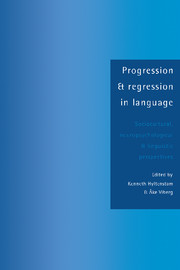 Progression and Regression in Language
Progression and Regression in Language Book contents
- Frontmatter
- Contents
- List of contributors
- Preface
- INTRODUCTION
- THE SOCIOCULTURAL SETTING
- PSYCHO- AND NEUROLINGUISTIC ASPECTS
- THE LINGUISTIC PERSPECTIVE 1: DISCOURSE, GRAMMAR, AND LEXIS
- 10 Crosslinguistic perspectives on native language acquisition
- 11 Syntactic development in Danish L2
- 12 The weaker language in bilingual Swedish-French children
- 13 Four operating principles and input distribution as explanations for underdeveloped and mature morphological systems
- 14 Crosslinguistic perspectives on lexical organization and lexical progression
- 15 Attrition or expansion? Changes in the lexicon of Finnish and American adult bilinguals in Sweden
- THE LINGUISTIC PERSPECTIVE 2: PHONOLOGY
- Index
11 - Syntactic development in Danish L2
Published online by Cambridge University Press: 06 July 2010
- Frontmatter
- Contents
- List of contributors
- Preface
- INTRODUCTION
- THE SOCIOCULTURAL SETTING
- PSYCHO- AND NEUROLINGUISTIC ASPECTS
- THE LINGUISTIC PERSPECTIVE 1: DISCOURSE, GRAMMAR, AND LEXIS
- 10 Crosslinguistic perspectives on native language acquisition
- 11 Syntactic development in Danish L2
- 12 The weaker language in bilingual Swedish-French children
- 13 Four operating principles and input distribution as explanations for underdeveloped and mature morphological systems
- 14 Crosslinguistic perspectives on lexical organization and lexical progression
- 15 Attrition or expansion? Changes in the lexicon of Finnish and American adult bilinguals in Sweden
- THE LINGUISTIC PERSPECTIVE 2: PHONOLOGY
- Index
Summary
This chapter reports on a longitudinal study of the acquisition of Danish syntax by young immigrants to Denmark (Holmen, 1988, 1990). The study deals with the early syntactic development, in formal, as well as functional, terms, of six adolescent speakers of Albanian, English, and Vietnamese.
In a way the study is a traditional interlanguage (IL) study in which a number of learners of a target language is followed for a certain period of time with the purpose of establishing similarities and differences in their learning process. On the other hand the study is more influenced by functional grammar and by interactional approaches to language than most interlanguage studies – or at least more than the early ones. Today functional analyses seem to be gaining support in this area (Sato, 1990; Huebner, 1983) in much the same way as in child language research (e.g. Berman, this volume).
The present study was designed when performance analysis (Faerch, 1979), variability in IL (Hyltenstam, 1978; Tarone 1982), and discourse analysis (Hatch, 1978; Larsen-Freeman, 1980) were the focus of second language researchers’ attention. More than anything else the study was inspired by Evelyn Hatch's claim that ‘one learns how to do conversations, one learns how to interact verbally, and out of this interaction syntactic structures develop’ (1978:404). However, the study did not really take shape till the analysis of IL data was combined with the functional approach, which was emerging as a new paradigm within linguistics (e.g. Givon, 1979, 1985; Dik, 1978, 1989).
- Type
- Chapter
- Information
- Progression and Regression in LanguageSociocultural, Neuropsychological and Linguistic Perspectives, pp. 267 - 288Publisher: Cambridge University PressPrint publication year: 1994
